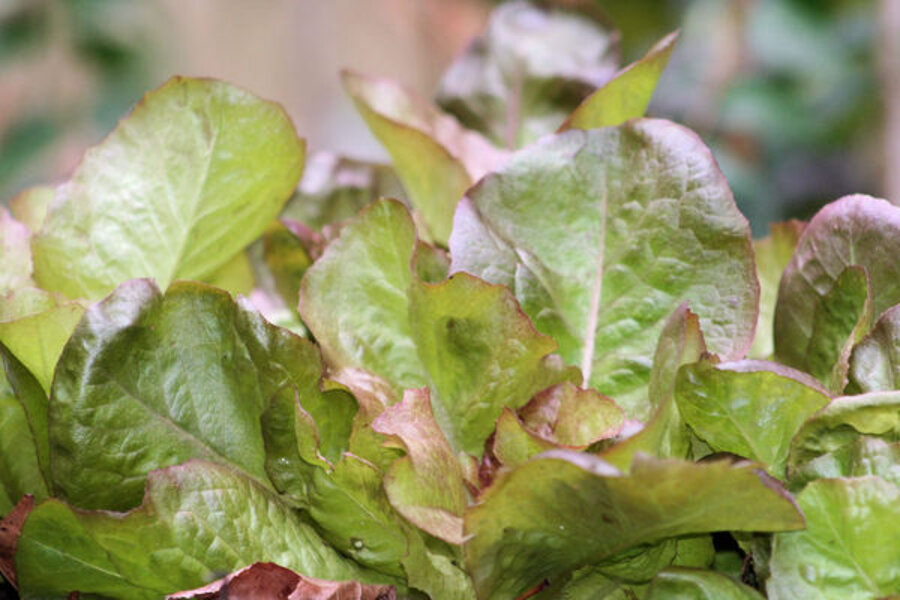How to grow and serve lettuce
Loading...
Lettuce likes it cool, says Anne Moore, the gardener, explaining how to grow the popular salad veggie. You will get your best stand of lettuce if the nighttime temperatures are below 70 F. (21 C).
Another deterrent to germination is planting the seeds too deep. Lettuce seeds need light to sprout, so barely cover the seeds with a thin sifting of soil.
You can scatter seed over a garden bed, row, or a container. Once the lettuce is up and growing, thin the little plants so that they have about seven inches between them. If you are growing a heading type, such as Buttercrunch, the plants should be 12 inches apart.
Lettuce needs a good deal of water, by way of faucet or rain, to grow into a decent cutting crop. Nitrogen is also essential for good leafy growth.
Use thick mulch, once the plants are up, to keep the soil cool and damp.
Watch out for hot weather
If the days turn to summer and the temperatures skyrocket, your lettuce crop will bolt. Bolting is just another garden word for sending up a seed stalk. Once this happens, the lettuce will develop a bitter taste and should be tossed on the compost pile.
But even if you live in a hot climate, you can get a quick crop of homegrown lettuce if you are careful in choosing the seed to plant,. It only takes a week or two for the seed to push little green plants up out of the ground. Some heat-tolerant lettuces include Deer Tongue, Bronze Mignonette, Oakleaf, and Buttercrunch, my personal favorite. All are somewhat slow to bolt.
During the warmer days of summer, shading the plants becomes more important. Using a shade cloth to enclose your lettuce bed will help keep the plants cooler and will keep insects off the leaves.
If you grow your lettuce patch in a container, choose a plastic pot. Plastic pots won’t need watering as often as clay, which tends to dry out very quickly. You can even grow lettuce in a flower border. The colors and frills of the leaves are very ornamental. They will make a lovely border you can munch on as you admire your flowers.
My favorite chicken salad on fresh garden greens
There are two chicken salad recipes that I love, says Chef Linda Weiss. One is my mother’s. She always made delicious chicken salad. Mother did not do anything special, just used chicken, celery, mayonnaise, chopped boiled eggs, and diced apples.
It is the old Southern chicken salad that most of our mothers made down South. We grew up with it, and if we were having company, or if we were the company, there was always a big bowl of Mother’s chicken salad in the refrigerator.
The second wonderful recipe is one that I received from a friend several years ago. I have shared it with many people, and each time that I see anyone that I’ve shared the recipe with they always tell me that it has become their favorite chicken salad -- just as it has become mine.
If you want a special salad to serve over those pretty fresh garden greens you’ve just grown, then this is the salad for you. It is the most delicious fruited salad you will taste, without a doubt.
The hint of curry, the taste of the chutney, and the pineapple that mixes with the mayonnaise and makes its own dressing is just incredibly delicious. Then you get the texture of the walnuts or almonds, the crunch of the celery and the sweetness of the golden raisins.
Now you understand, right? Excuse me while I go cook chicken. Enjoy.
Most Favorite Chicken Chutney Salad
Linda Weiss
2 cups diced, cooked chicken breast
1 apple, peeled, cored, and diced
1 small can pineapple chunks, drained
1/2 cup golden raisins
1 stalk celery, thinly sliced
2 green onions, thinly sliced
1/2 cup toasted walnuts or sliced almonds
2/3 cup or more mayonnaise
1/2 jar Major Grey's mango chutney
1/2 teaspoon or more curry powder
Mix all ingredients together, blending well. Add more mayonnaise if needed to make the salad very creamy.
Serve on a mound of fresh green lettuce with strawberries or any fresh fruit, and add your favorite poppy seed dressing or Vidalia onion dressing around the greens.
Editor's Note: To read more of Anne and Linda's "how to grow and prepare" series, click here. So far they've written about asparagus, beets, carrots, dill, strawberries, and tomatoes.
-----
Linda Weiss and Anne Moore met while Linda was the food editor and Anne was the garden editor for South Carolina Homes & Gardens magazine. They now write articles for the ETV GardenSMART television show website, where Anne is the horticulture editor, gardening consultant, and e-newsletter editor. Anne has also written for magazines and newspapers and is a member of and a recipient of a Silver Award for magazine writing from the Garden Writers Association. Linda is a personal chef. She attended Le Cordon Bleu of Paris’ catering program, has appeared as a guest chef on numerous television shows, has been a culinary educator for 10 years, and a food writer for a number of magazines. She is a professional member of The James Beard Foundation and the Southern Foodways Alliance and has written a cookbook, "Memories From Home, Cooking with Family and Friends."






